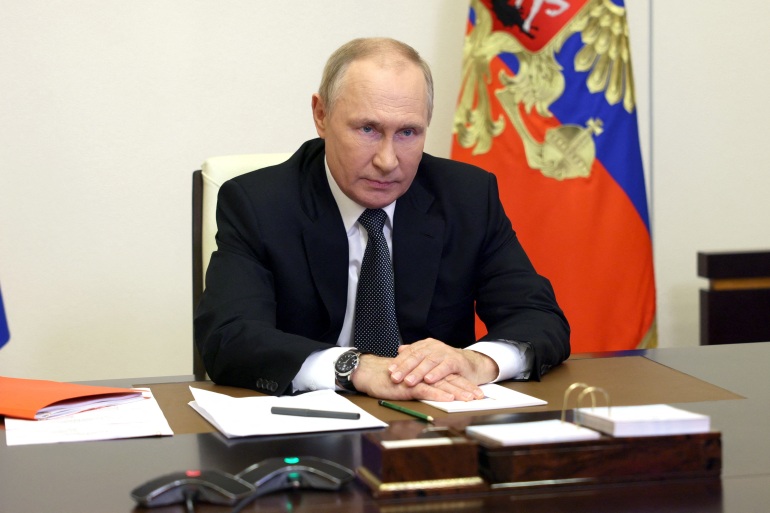Russian President Vladimir Putin on Wednesday introduced martial law in Ukrainian Donetsk, Lugansk, Kherson and Zaporizhzhia regions that Moscow claims to have annexed.
“I signed a decree to introduce martial law in these four subjects of the Russian Federation,” Putin said during a televised National Security Council meeting.
The Kremlin then published a decree saying martial law will be introduced from early Thursday.
Related news
- Ukraine mocks Moscow with parade of destroyed Russian tanks
- 20% of Ukraine under Russian Control- says Zelensky
- Putin vows to continue Russia’s bloody offensive in Ukraine
Putin’s announcement came as Ukrainian forces advanced in territory held by Moscow for months.
“The Kyiv regime refused to recognise the will of the people, rejects any proposals for negotiation, gunfire continues, civilians are dying,” the 70-year-old Russian leader said.
He accused Ukraine of using “terrorist methods.”
“They send sabotage groups into our territory,” he said, claiming Moscow had foiled other attacks after its Crimea bridge was targeted “including at our nuclear power facilities.”
Under Russian law, martial law allows for the strengthening of the military, curfews, limits on movement, forms of censorship and the interning of foreign citizens.
“We are working on solving very complex large-scale tasks to ensure security and protect the future of Russia,” Putin said.
According to the decree, he also strengthened security inside Russia, putting Moscow-annexed Crimea and the southern regions of Krasnodar, Belgorod, Bryansk, Voronezh, Kursk and Rostov on a “medium level of response.”
This includes moving some residents to “safe zones,” introducing checks on entering and leaving the regions and strengthening security on infrastructure.
In the central federal district, which includes Moscow, a regime of “strengthened alert” was introduced, the decree said.
Kyiv, which does not recognise Moscow’s self-styled annexations of the four regions, derided the move.
“‘Martial law’ implementation on the occupied territories by Russia should be considered only as a pseudo-legalisation of (the) looting of Ukrainians’ property,” tweeted Mykhailo Podolyak, a Ukrainian presidential adviser.
Eight months after being invaded, Ukraine is prosecuting major counter-offensives in the east and south to try to take as much territory as it can before winter after routing Russian forces in some areas.
The conflict has killed thousands, displaced millions, pulverised Ukrainian cities, shaken the global economy and revived Cold War-era geopolitical fissures.
Putin also issued a decree restricting movement in and out of eight regions adjoining Ukraine and ordered the creation of a special coordinating council under Prime Minister Mikhail Mishustin to step up the faltering war effort.
Kherson is the biggest population centre Moscow has seized and held since it began its “special military operation” in Ukraine on Feb. 24.
Andriy Yermak, head of the Ukrainian president’s office, accused Russia of laying on a propaganda show there.
“The Russians are trying to scare the people of Kherson with fake newsletters about the shelling of the city by our army, and also arrange a propaganda show with evacuation,” Yermak wrote on the Telegram messaging app.
Andriy Yermak, head of the Ukrainian president’s office, accused Russia of laying on a propaganda show there.
“The Russians are trying to scare the people of Kherson with fake newsletters about the shelling of the city by our army, and also arrange a propaganda show with evacuation,” Yermak wrote on the Telegram messaging app.
‘LOOMING OFFENSIVE’
Ukrainian cities have also been struck in recent days by drones and missiles, and Vitali Klitschko, Kyiv’s mayor, said the capital’s air defences were in action once again on Wednesday.
Ukrainian President Volodymry Zelenskiy, who has said a third of his country’s power stations have been hit by Russian strikes, on Wednesday discussed security at power supply facilities with senior officials.
“We are working to create mobile power points for the critical infrastructure of cities, towns and villages,” Zelenskiy wrote on the Telegram messaging app.
“We are preparing for various scenarios of possible consequences. Ukraine will defend itself. No matter what the enemy plans and does.”
In Kherson, Stremousov said the city and especially its right bank could be shelled by Ukrainian forces, adding that residents who left would be given accommodation inside Russia.
“I ask you to take my words seriously and to interpret them as a call to evacuate as fast as you possibly can,” he said.
“We do not plan to surrender the city, we will stand until the last moment.”
The Russian-installed chief of Kherson region, Stremousov’s boss, said about 50,000-60,000 people would be evacuated in the next six days. The city of Kherson had a pre-war population of around 280,000 people but many of them have since fled.
“The Ukrainian side is building up forces for a large-scale offensive,” Vladimir Saldo, the official, told state TV. “Where the military operates, there is no place for civilians.
Saldo, who said Russia had the resources to hold Kherson and even counter attack if necessary, also said he was banning civilians from entering the region for seven days. Staff at Kherson’s Russian-backed administration were also being relocated to the left bank of the Dnipro, he said.
The evacuation calls followed a gloomy assessment of Russia’s prospects in the area from General Sergei Surovikin, the new commander of Russian forces in Ukraine.
“The situation in the area of the ‘Special Military Operation’ can be described as tense,” Surovikin told state-owned Rossiya 24 news channel. “The situation in this area (Kherson) is difficult. The enemy is deliberately striking infrastructure and residential buildings.”
(AFP/Reuters)

